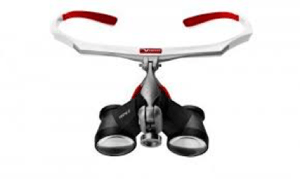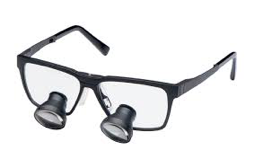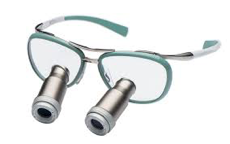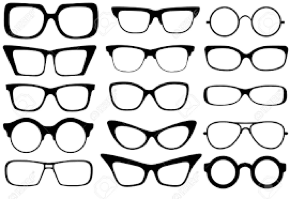Working distance, Depth of Field, Declination, Frame size
Working distance is the distance from the eyes to the work area. Reputable companies selling loupes will have trained people who can measure your working distance in a variety of treatment positions around the head of the patient whilst maintain good posture and minimise excessive neck flexion or hunching. Working distances will vary for shorter operators (35 cm’s or less) to very tall operators (more than 50 cm). Therefore, working distance should be tailored to the individual.
The depth of field is the viewing distance whereby the loupes remain in focus, which in practical terms, means the distance you are able to move closer or away from the patient, without your loupes losing focus and is also dependent on the magnification selected, see below what magnification should I choose, the illumination available in the oral cavity and the working distance. To ensure that best posture is maintained to minimise excessive neck flexion and hunching most companies recommend the working distance to be slightly long so that the range of the depth of field is maximised.
Declination angle is the angle that your eyes are inclined downward toward the work area. This angle should be steep enough to help you attain a comfortable working position with minimal forward head posture (20 degrees or less). The farther the head is positioned forward to see through the loupes, the greater the strain on the neck. Too extreme of a downward declination angle can cause eye strain; however, this is a rarely observed problem clinically.
By far the predominant problem regarding declination angles is insufficient (small) angles that force the operator to assume unhealthy working postures. Since glasses rest differently on each face, the same pair of loupes may have a slightly different declination angle from one person to the next, depending on interpapillary distance, nose bridge height, and other variables. However, the declination angle that various manufacturers offer varies dramatically, and can either benefit or worsen your musculoskeletal health.
Keep in mind to that, the lower the manufacturer can place the loupe in relation to your pupil, the better declination angle they can generally provide for you.
Buyers should always request that the TTL scope be placed as low in the frame as possible.
What Magnification should I choose?

The higher the magnification the lower the field of view. When starting out with your first pair of loupes it is suggested to start with a low magnification, such as a 2.5X. This will assist in the process of adjusting to loupes which is made easier if the magnification is lower because the field of view is wider than with a higher magnification. The reduction in the field of view from the naked eye is probably the biggest change to get used to when wearing loupes. A higher magnification is suggested to those who have worn loupes in the past and are confident with a smaller field of view.
You may also like to consider a higher magnification when treating patient that require endodontic treatments. A higher magnification allows canals to be found, accessed and mechanically prepared with far greater accuracy. Certain canals like the mesiobuccal 2 (MB2) of upper first molars are near impossible to locate without magnification. It has been shown that the detection rates of MB2 canals increase with loupes magnification from 17.2% with the naked eye, to 62.5% with loupes and 71.1% with a microscope (1). Untreated MB2 canals have been implicated in many failed root canal treatments (2).
TTL or Flip Up?

There are two designs of loupes: ‘Through the Lens’ loupes [TTL] and ‘Flip-Up’ loupes.
With flip up loupes the optics are attached to a moveable arm which can then be manually adjusted to suit anyone. You may consider flip ups if you wear prescription glasses. Flip up loupes will allow you to easily ‘flip up’ the optics so you can see through your prescription lenses or the naked eye.
Through the lens or TTL as they are better known have the optics built into the glasses with the specifications, such as inter pupillary distance customised to your eyes. The advantages of TTL are they are customised especially to you, hence the optics will always be in the correct position. They are also lighter weight making them more comfortable to wear all day. You also get a wider field of view as the optics are closer to the eyes.
Galilean or Prismatic Loupes?
When selecting loupes you have the choice of either Galilean or Prismatics.
Galilean loupes are the most popular style of loupes as they are lightweight and offer easier adaptability. Galilean loupes are generally offered in magnification ranging from 2.0X -3.0X making them the perfect choice for dentistry procedures.
Prismatic loupes are heavier in weight but do offer a higher magnification level. If you want your loupes to have greater clarity and to be of a higher magnification level then these may be the loupes you wish to consider. Additionally they are great for more detailed work like endodontics. Magnifications range from 3.5X to 6.0X


Is the weight of Loupes important?

Certainly is. The weight of the Loupes is an important consideration when purchasing loupes. If the loupes are too heavy they can be uncomfortable to wear - especially during long procedures.
Loupes that are mounted onto good quality frames will distribute the weight evenly across the bridge of the nose and ears and around the head, offering you a more comfortable working position.
As a consequence of choosing light weight dental loupes and a frame with even distribution of weight is that: long term tension and other back, neck and shoulder complications will be minimised or even prevented.
Should I be using additional illumination with my loupes?
LED lighting is now main stream when preforming procedures with loupes. Dental Loupes with mounted headlights can significantly improve your field of vision effortlessly and improve light to the area.
How to choose the right frame?
The biggest issues with frames are design, function and cost. Opting for highest design appeal without consideration for other factors may result in a disappointing experience with TTL loupes, as satisfaction is closely related to frame stability and adjustability.
Frames that are designed for function will offer users high stability and adjustability (post-purchase adjustments are possible by the manufacturer's technical representatives), however some may be heavy and uncomfortable for extended wear, or may offer poor balance and weight distribution. Also consider that because glasses rest differently on each face, depending on nose bridge height, and other variables including ethnic background it is important to find frames that are comfortable for you.
Loupes are a very personal and a unique tool for your everyday use that should be perfectly tailored to you and your lifestyle. Chose a frame that reflects your personality and who you are. Think about the look you are after – is it trendy, sporty, glamour or more urban life? Also think about what your patients may think and perceive when they see you and your dental team wearing loupes. Wearing loupes may give your patients more confidence in the procedure you are completing.
A user should look for a stable, comfortable, well-balanced frame that will hold up to years of wear-and-tear, and meets the aesthetic requirements of the user. The best frames will be designed specifically for loupes. Quality titanium frames can be aesthetic, stable, functional and ideal.
How do I manage my current prescription and what happens if my prescription changes
It is important that you have the option of fitting your loupes frames with the correct prescription. Otherwise, the loupes will not perform according to specifications. Most reputable manufacturers will request a prescription that has been issued in the last 6 months because small changes in vision are often not perceivable by the user, but custom-made loupes are designed to work at specific distances, and the manufacturing process is based on corrected eye-sight.
Depending on the type of loupes you choose (TTL or Flip Ups) and your frame choice, the prescription placement location will vary. Prescriptions are able to be placed in either the optical barrels, in the carrier frame or both.
If your prescription changes the reputable suppliers of Loupes are able to send your new prescription and loupes back to manufacturer for the adjustments to be made and whilst there is most probably a cost to do so it is less than purchasing a new pair of loupes.
If a user normally wears contact lenses with single prescription, they can be worn with loupes, and loupes can be ordered without prescriptions. However, if this user decides not to wear the contact lenses, the loupes will not work correctly as the focal distances and other factors may be affected.
A technical loupe representative will be able to advise users on the effects of prescriptions for peripheral vision, such as communication with others, writing tasks, viewing instruments, using computers, etc.

Satisfaction guarantees, adjustments or changes, and warranties:
In some cases, a loupe and light purchase requires servicing due to the high number of factors that go into custom-making loupes. It is important to deal with someone that can service your needs post-purchase. Users will be wearing loupes for extended periods and may sometimes discover that they need changes in working distances, adjustments to the frames to realign the oculars, frame corrections, and many other local services.
Users should know what happens if the loupes don't offer the anticipated performance. What is the warranty? What is the satisfaction guarantee? What happens if the user needs a new working distance?
Call customer service to make a time with your rep.
Click here to see our full range of Loupes
References
- Buhrley LJ, Barrows MJ, BeGole EA, Wenckus CS (2002) Effect of magnification on locating the MB2 canal in maxillary molars. J Endod 28(4): 324-327
- Wolcott J, Ishley D, Kennedy W, Johnson S, Minnich S, Meyers J (2005) A 5 yr clinical investigation of second mesiobuccal canals in endodontically treated and retreated maxillary molars. J Endod 31(4): 262-264.
.png)
